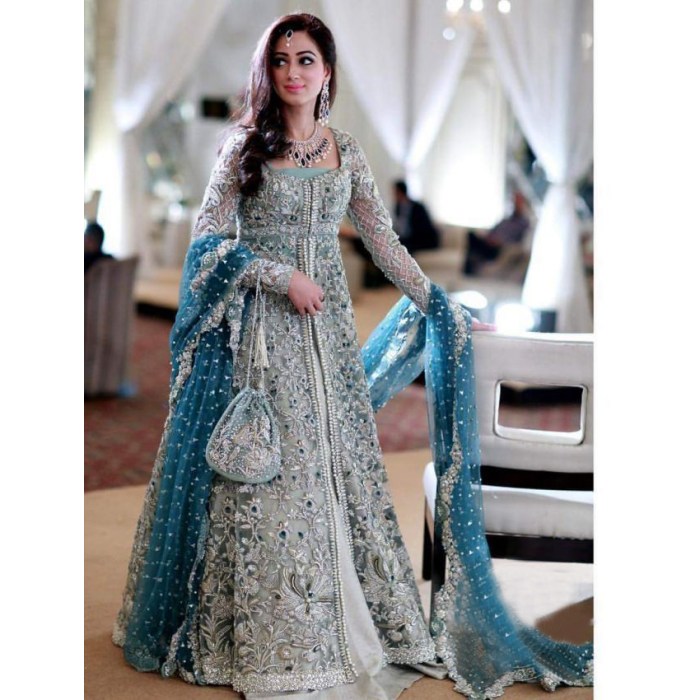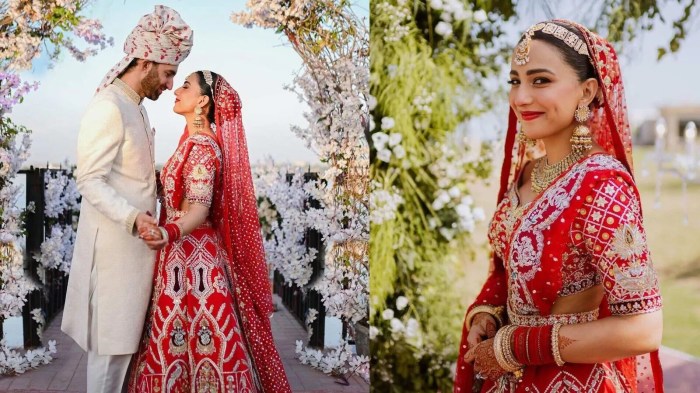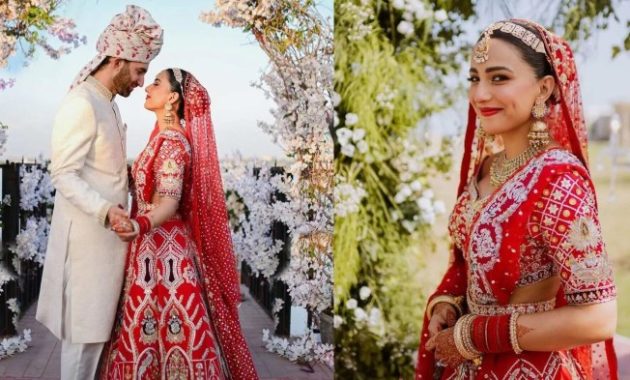Popular Pakistani Wedding Dress Styles
Pakistani wedding party wear dresses – Pakistani wedding attire is a vibrant tapestry of tradition and artistry, showcasing a diverse range of styles that reflect regional influences and cultural significance. The choice of dress is often a deeply personal one, reflecting family heritage and individual preferences. Five prominent styles stand out, each with distinct features and cultural weight.
Five Prevalent Pakistani Wedding Dress Styles
The five most prevalent Pakistani wedding dress styles are: the Gharara, Sharara, Lehnga Choli, Anarkali, and Frocks. These styles vary significantly in their silhouette, fabric choices, and embellishment techniques.
| Style Name | Fabric | Embellishment | Silhouette |
|---|---|---|---|
| Gharara | Silk, Net, Velvet | Zari, Embroidery, Stones | Wide-legged trousers paired with a short or long kurta |
| Sharara | Silk, Chiffon, Organza | Mirror work, Gotta Patti, Sequins | Similar to Gharara but with wider, more flared trousers |
| Lehnga Choli | Silk, Velvet, Brocade | Heavy embroidery, Zardozi, Kundan | Long, flared skirt paired with a fitted blouse (choli) |
| Anarkali | Silk, Net, Georgette | Embroidery, Applique, Beadwork | Long, flowing gown with a fitted bodice and flared skirt |
| Frock | Silk, Chiffon, Jacquard | Lace, Embroidery, Resham work | A knee-length or floor-length dress, often with a fitted waist |
For example, a traditional Lehnga Choli might feature heavy Zardozi embroidery on a rich velvet fabric, creating a regal and opulent look. In contrast, a modern Anarkali might incorporate lighter fabrics like chiffon or net, with intricate embroidery and delicate embellishments for a more contemporary feel.
The vibrant hues and intricate embroidery of Pakistani wedding party wear dresses often necessitate equally striking footwear choices. To complement a bold ensemble, consider the impact of a pair of eye-catching shoes, such as those showcased in this selection of orange dress shoes for wedding , which can add a sophisticated touch to the overall look. The right shoes can elevate a traditional Pakistani outfit, ensuring a cohesive and memorable style statement.
Regional Variations in Pakistani Wedding Attire

Source: styleglow.com
Pakistani wedding attire showcases significant regional diversity, reflecting the rich cultural heritage of different areas. The styles, fabrics, and embellishments vary considerably across the country.
Regional Attire Variations
Three distinct regions—Punjab, Sindh, and Balochistan—exemplify this regional variation. Each region’s unique cultural influences shape the design, materials, and techniques used in wedding attire.
- Punjab: Known for its vibrant colors and intricate embroidery, Punjabi wedding dresses often feature heavy embellishments like Zardozi, gotta patti, and mirror work on fabrics such as silk, velvet, and brocade. Lehngas and Shararas are popular choices.
- Sindh: Sindhi wedding attire is characterized by its simpler, more understated elegance. While embroidery is used, it’s often less elaborate than in Punjab. The use of traditional Ajrak prints and lighter fabrics like cotton and muslin is common. The silhouette tends towards long, flowing dresses.
- Balochistan: Baloch wedding dresses are known for their rich colors and unique embroidery styles. The use of traditional hand-woven fabrics, often incorporating intricate geometric patterns, is a defining feature. The dresses are typically long and flowing, with heavy embellishments.
Color Palettes and Trends in Pakistani Wedding Dresses: Pakistani Wedding Party Wear Dresses
Color plays a vital symbolic role in Pakistani weddings, with certain shades representing prosperity, joy, and good fortune. Current trends blend traditional palettes with modern interpretations.
Color Palette Trends
Traditional colors such as red (symbolizing passion and good luck), gold (representing wealth and prosperity), and green (signifying fertility and growth) remain popular. However, pastel shades and other contemporary color combinations are also gaining traction.
| Color Name | Hex Code | Symbolic Meaning | Usage in Dress Design |
|---|---|---|---|
| Maroon | #800020 | Royalty, richness | Base color for a Lehnga, accented with gold embroidery |
| Emerald Green | #508000 | Fertility, prosperity | Used in the dupatta or as an accent color on a lighter base |
| Gold | #FFD700 | Wealth, prosperity | Embroidery, embellishments, and accessories |
| Ivory | #FFFFF0 | Purity, elegance | Base color for a more modern, minimalist look |
A contemporary palette might incorporate a deep maroon base, accented with emerald green and gold embroidery, offering a blend of traditional symbolism and modern aesthetic.
Embellishments and Fabrics Used in Pakistani Wedding Dresses

Source: livemint.com
The richness and beauty of Pakistani wedding dresses are largely defined by the choice of fabrics and embellishments. The techniques used are often passed down through generations, representing a legacy of craftsmanship.
Embellishments and Fabrics, Pakistani wedding party wear dresses
Common embellishments include Zardozi (metal thread embroidery), Aari (needlepoint embroidery), gotta patti (decorative lace), mirror work, and stonework (using crystals, pearls, or Kundan). Luxurious fabrics like silk (Banarasi, Raw silk), velvet, chiffon, net, and organza are frequently used, each offering unique properties and suitability for different styles. For instance, the heavy embellishments of Zardozi work particularly well on the luxurious texture of velvet, creating a rich, three-dimensional effect.
The visual impact of Zardozi embroidery on velvet is striking. The metallic threads catch the light, creating a shimmering effect that complements the deep, plush texture of the velvet. The intricate designs, often featuring floral motifs or geometric patterns, add a layer of visual complexity and opulence to the garment.
Modern Interpretations of Traditional Pakistani Wedding Dresses
While tradition remains deeply valued, modern designers are reinterpreting classic styles to appeal to contemporary tastes. This involves innovative use of fabrics, embellishments, and silhouettes.
Modern Adaptations
Modern interpretations often retain the essence of traditional designs while incorporating contemporary elements. This could involve using lighter fabrics like chiffon or net for a more flowy silhouette, or experimenting with asymmetrical cuts and modern embellishment techniques.
- Modern Lehnga:
- Silhouette: A-line or mermaid cut
- Fabric: Flowing silk or net
- Embellishment: Minimalist embroidery or subtle sequin work
- Contemporary Anarkali:
- Silhouette: Fitted bodice with a flowing, asymmetrical skirt
- Fabric: Lightweight chiffon or organza
- Embellishment: Delicate embroidery or lace detailing
- Reimagined Gharara:
- Silhouette: High-waisted, wide-legged trousers with a cropped top
- Fabric: Silk or a blend of silk and cotton
- Embellishment: Subtle embroidery or minimal embellishments
Accessorizing Pakistani Wedding Dresses
Accessories are integral to completing a Pakistani bridal look, adding layers of detail and cultural significance. Jewelry, footwear, and veils all contribute to the overall aesthetic.
Accessorizing the Bridal Ensemble
Traditional jewelry plays a significant role, with pieces like jhumkas (earrings), bangles, necklaces, and maang tikkas (forehead ornaments) carrying cultural weight and enhancing the bridal look. The choice of footwear, often embellished shoes or juttis (traditional footwear), complements the dress and adds to the overall ensemble. A dupatta (scarf) or veil, often intricately embroidered or embellished, adds a final touch of elegance and grace.
A complete ensemble might include a richly embroidered Lehnga Choli in a deep maroon hue, paired with gold Kundan jewelry, embellished juttis, and a matching dupatta, creating a cohesive and visually stunning bridal look.
Key Questions Answered
How much does a typical Pakistani wedding dress cost?
Prices vary wildly depending on the fabric, embellishments, designer, and level of customization. You can find simpler options for a few hundred dollars, while high-end, bespoke pieces can cost thousands.
Where can I buy Pakistani wedding dresses?
You can find Pakistani wedding dresses at both local boutiques specializing in South Asian clothing and online retailers. Check out Etsy, Amazon, and dedicated South Asian fashion websites.
Can I rent a Pakistani wedding dress?
Yes, renting is a great option if you’re on a budget or only need the dress for one event. Many bridal shops and online platforms offer rental services.
What is the best way to care for a Pakistani wedding dress?
Always check the care label! Many fabrics require dry cleaning. For delicate embellishments, hand washing might be necessary. Store your dress in a breathable garment bag to protect it from dust and damage.

